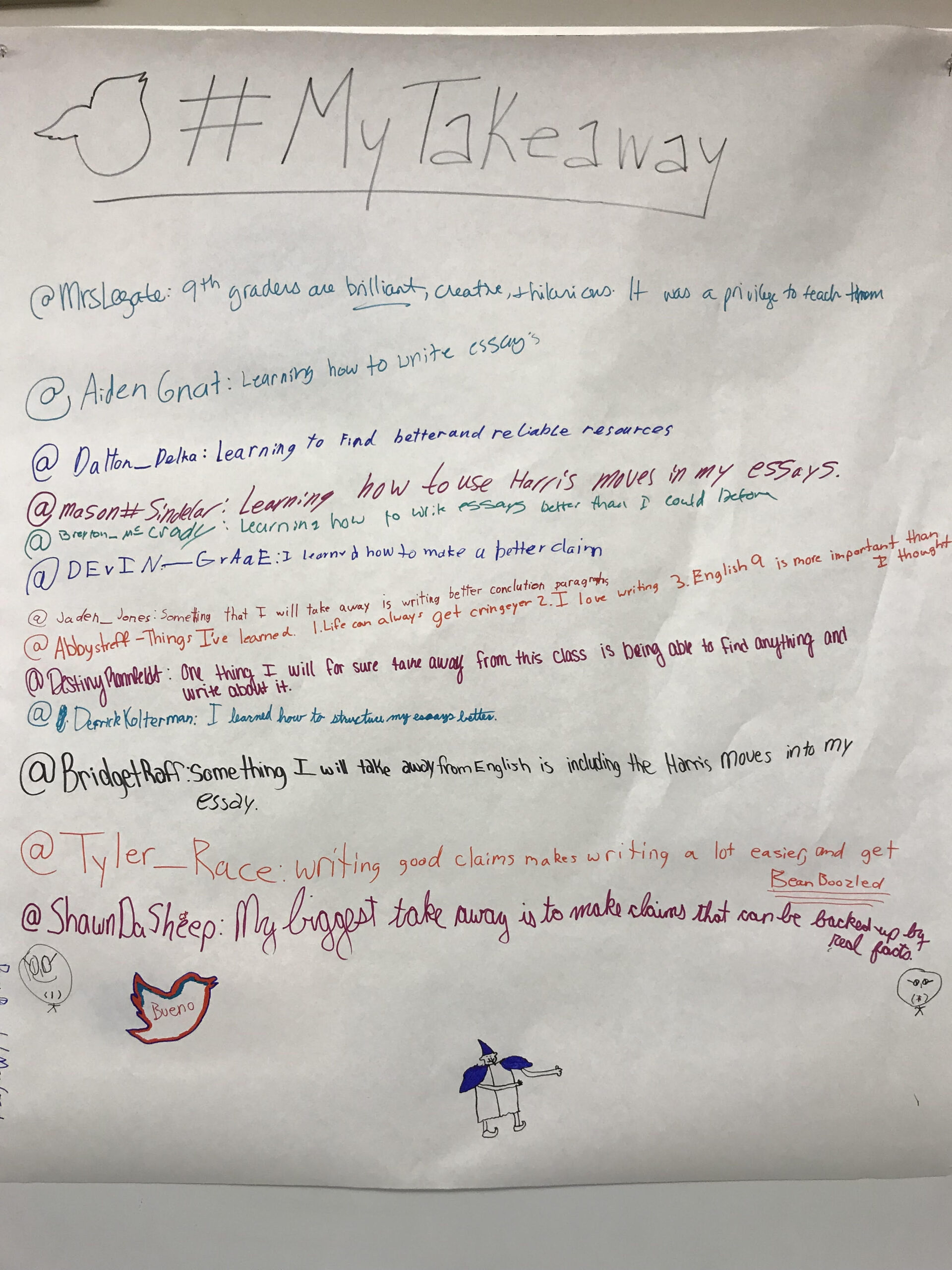It was the end of the period in English 9. My students and I were wrapping up day four of a mini-unit on argument writing, one from the College, Career, and Community Writers Program (C3WP) called Writing and Revising Claims. For the past several days, we’d been reading varying perspectives on the topic at hand, and it was time for them to say their piece in this larger conversation.
“Okay, everyone, for tomorrow, I’d like you to write down your claim on this issue. But before you do that, take a look back at everything you’ve written over the past four days, starting from the very beginning when you wrote your own ideas about the topic before we had read anything and then glancing through your reactions to the perspectives we’ve read. Pay attention to what you notice about how your thinking has evolved and why.”
Then, a student spoke up. “I’m thinking deeper and letting in new ideas, comparing it to my original idea and realizing how different I’m actually thinking now.” Her words made me immediately stop, run to my keyboard, and ask her to repeat what she’d just said so that I could remember it later, for it was exactly the kind of thing all teachers hope their students are able to see for themselves.
Then, another student: “We should do this more often. It’s fun.” My teacher-heart soared.
As the bell rang, I thought back to my early years as an educator. I began my career in 2012 teaching English 9 at Pierce Public Schools. I remember an early conversation with a fellow teacher (one with a lot more experience than I) who asked me, “What’s something you do well in your classroom?”
Crickets. I had no idea how to respond because if I were being honest with myself and this other person, I didn’t really think I did anything all that well.
Like many of us, I remember my first couple of years of teaching as…rocky. Especially when it came to teaching writing. Most of my students’ work in those years revealed serious holes in my instruction. Their thesis statements were wishy-washy, their selection of supporting evidence often random and cherry-picked, and their explanation of said evidence either missing or shallow. I knew the skills I wanted to teach them, but for some reason, things were getting lost in translation.
The Transformation Begins
Fortunately (for both my students and me), I found my way to the Nebraska Writing Project in 2015 when I took the Summer Institute, a four-week program for teachers of all disciplines and levels. We wrote. We inquired. We researched. We shared best practices. We wrote some more.
Through the most intense, transformative professional development I’d ever experienced (or have to date), I began to feel equipped with what I needed to be a better writing teacher: a network of fellow educators, a treasure trove of new strategies and resources shared by other participants, and most importantly, a new perspective on writing instruction altogether.
However, the most dramatic shift occurred when, through the Nebraska Writing Project, I was introduced to C3WP.
Being immersed in this program, I finally began to see the teaching moves I needed to make in order to convey to my students what quality writing is and how to do it. C3WP’s foundational principles equip teachers with instructional resources, skills, and strategies to guide students in crafting solid arguments. For me, I clearly saw concrete ways I could help fill those aforementioned holes in my students’ writing:
Helping them arrive at debatable, defensible, nuanced claims supported by reliable sources? Check.
Encouraging them to consider multiple perspectives? Check.
Purposefully using evidence to support their claims? Check.
Commenting on that evidence’s relationship to their claim? Check! Plus so much more!
I also fell madly in love with C3WP due to its obvious relevance to my students’ lives outside school. Yes, I wanted them to be able to write effective essays and arguments, but most importantly, I wanted them to leave the four walls of our school equipped with “real world” skills.
As our society sees the quality and true purpose of argument deteriorate in this us vs. them cultural moment, one such skill will be their ability to base their viewpoints on reliable evidence and defend them without resorting to the tactics that they see on social media or cable news panel discussions (logical fallacies, interruptions, or even outright refusal to engage).
An early version of the C3WP website put it perfectly: the program “answers the contemporary call for respectful argumentative discourse.”
Bringing C3WP to My Classroom
In the school where I teach, much of our student body is homogenous, so students are often not directly confronted with views that differ much from their own. But C3WP’s way of approaching argument helps students learn to note the limits of their viewpoint and consider those of others. Check out the following claims developed by some of my English 9 students who received C3WP instruction the very first year I tried it out in my classroom. In response to the issue of protests, students arrived at the following claims:
- Protests work as a way to raise awareness and bring people to a common cause; if they aren’t well planned, then they won’t aid in bringing about change.
- Although protest [sic] may not completely solve a problem, the protests make problems known enough for people to take action.
- As long as protests don’t get violent, they can be very efficient.
- There have been many protests throughout the years in the United States, but are protests the most effective way to get things done? There are other ways to solve the problems at hand such as going straight to the government, you can also vote, or just take action.
- Even though protests are not always immediately successful, they make a difference in the long run.
- Although protests can be very moving, they are usually not the final factor in changing something that is unwanted. While protests widen the view on the argument they are fighting, they are not effective by themselves.
- I think protesting is a right we have at our disposal and something we should use, but nonetheless, mostly ineffective.
- Other than bringing people together, protests do not accomplish much in the big scheme of things.
- Even though protesting doesn’t change people’s minds immediately, protests are successful because it increases the visibility of the cause, demonstrates power, and energizes participants.
Their claims totally blew me away. Each of them takes the important step of noting the merits of another perspective, which at the same time, notes at least one limit of their own. They weren’t just doing better writing; they were doing better thinking.
And frankly, so was I.
Are you looking for ways to bring argument writing into your classroom? Ways to shake up your current approach? Ways to transform how you and your students approach discourse? C3WP just may be your answer.



